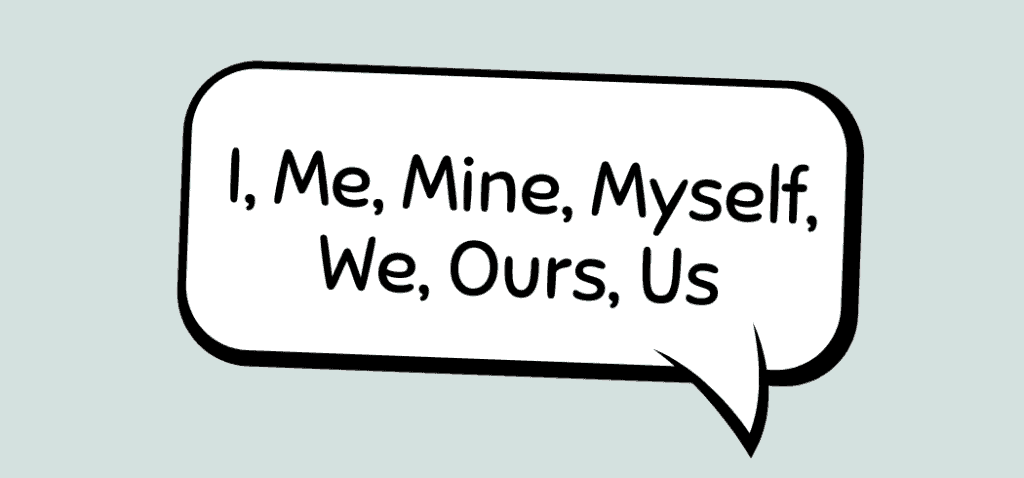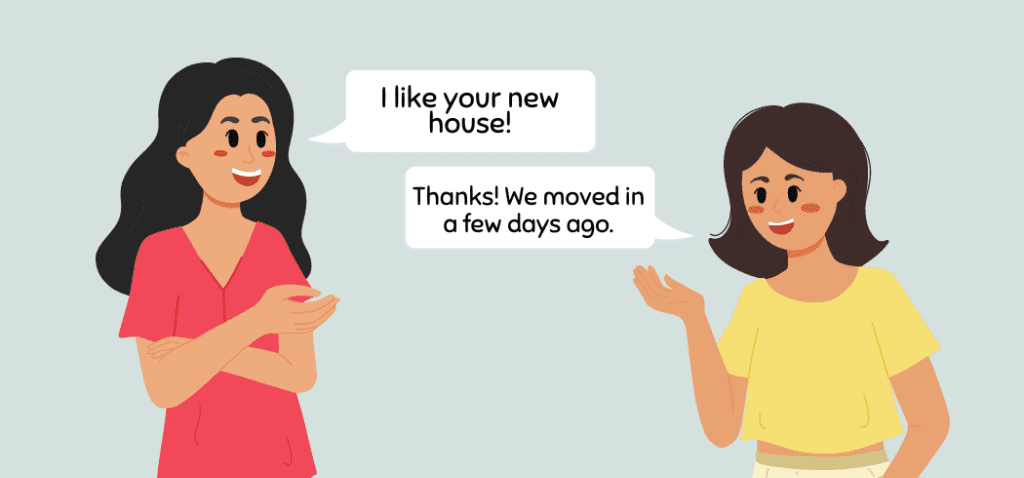Writing in 1st person allows the narrator to be part of the story, but it can be tricky to understand how to pull it off. Using I and we pronouns is just the first step in speaking in the first person, so let’s discover more about the first person point of view as I break it all down for you.
What Is First Person POV?
First-person POV is a writing style where the author or narrator is part of the story. It uses first-person pronouns (such as I and we) and tells the story from their own perspective.
I employ the first person POV when looking to tell the story from the eyes of the narrator or main character. But the storyteller can be a protagonist, antagonist, side character, or mere observer of the story unfolding before their eyes.
But, when writing in first person, you can’t ‘see’ or experience things from any other character’s point of view.
What Words Are in First Person?

The first-person pronouns used in writing include I, me, mine, myself, we, our, ours, and us.
How Do You Write in 1st Person?
To write in the first-person point of view, you need to be a part of the story. Use pronouns like I, me, and we. Become the storyteller as either the protagonist or a side character the observes the narrative around them.
Types of First Person POVs
The kind of first-person point of view used in a story is decided by the part the narrator plays in the tale. Who should serve as the story’s narrator, and in what first-person voice should it be told? This question can be answered by the story’s components, such as its genre.
- First-person central – When the narrator is a protagonist in the story and takes an active part in the plot.
- First-person peripheral – When the narrator witnesses the story but they are not the main character.
First, Second, and Third Person Pronouns
Each of the three narrative perspectives uses a specific set of pronouns, as follows:
- First-person: I, me, mine, myself, we, us, ourselves, ours.
- Second person: you, your, yours.
- Third person: he, him, his, himself, she, her, hers, herself, it, its, itself, they, them, their, theirs, themselves.
Examples of First Person POV in Writing

As a first-person POV writer, you should always consider how the events unfold from the point of view of the character you’ve chosen to serve as your POV.
Consider that your perspective of view is similar to a lens. The event is taking place, but we require a lens to understand it. Our point-of-view character may have a purple lens, which would color everything purple.
When you are writing, remember what the character whose point of view you are using thinks of the setting. Give importance to their responses and how they would characterize the events.
Here are some first-person narrative examples:
- We sat there and watched as the events unfolded before our very eyes. Craving to intervene, we soon realized there was nothing we could do. Fate was no longer in our hands.
- I just stood there looking in admiration, mesmerized by everything she had accomplished. I knew she had the fire inside her, but to amaze us all like that? All I could do at that moment was applaud.
- When I first stepped on that stage, time stood still. I felt a mixture of fear of fortitude and charisma overwhelmed by my shyness. The words were dry in my mouth, and, for a moment, I forgot every line I had repeated in my head time and time before.
When to Use First Person POV
One of fiction’s most prevalent points of view is the first-person perspective. When a character in a story uses the pronoun “I” to refer to themselves, they are said to be narrating in the first-person point of view. This form of narration lets readers understand the events through the eyes and ears of the storyteller.
Through the POV character’s eyes, the reader is immersed in the action of the novel from the very beginning. It has many purposes in storytelling, including establishing trustworthiness and authority in a story. Although it’s not the best choice for every story, the first-person point of view is quite common and crucial for writers to grasp.
Pros and Cons of First Person POV
Like any type of writing, there are right and wrong ways to use the first-person POV. In my professional opinion, these are the advantages and drawbacks of writing in the first person.
Pro: You Can Create an Immersive Experience
One of the primary advantages of using the first-person point of view is that it creates what is frequently called a “close psychic distance” between the characters in the story and the reader. Many writers, myself included, and readers choose writing from the first-person point of view because it gives a sense of intimacy. I love connecting with my characters through this POV.
Con: It Only Shows One Perspective
There are a bunch of ways in which the first-person POV can limit your story, especially if the narrator has a background that limits their vocabulary. Imagine people like children, those who have trouble learning, or those who are incredibly naive. They may be unreliable narrators. Also, since the author is not omnipresent, you will only see the story through their eyes.
Pro: You Can Describe Your Character Perfectly
If a writer can get inside the head of one particular character while writing, they may be able to create a protagonist who is richer and more complicated.
Compared to third-person POV characters, who are typically written from a more detached point of view, first-person POV characters tend to disclose themselves through their words, mindset, and explanations.
Using the first-person point of view also enables writers to incorporate literary devices like flashbacks into their work without disrupting the natural progression of the narrative.
Con: It Could Limit Your Subplots
When writing from a third-person point of view, a writer can produce several storylines by using a variety of characters to create subplots. However, a further drawback of using the first-person point of view is that it is very challenging to build subplots if your main character can’t be in them.
This is another downside of using the first-person point of view. Subplots expand the narrative potential of a book and offer the author additional ways to express the story she wants to tell.
But one workaround I use is sprinkling in a few alternative chapters from other characters’ POVs to round out complex subplots.
First Person Writing Examples from Literature
In literature, the first-person POV is often employed to show the narrator is part of the story. The writing thus becomes more personal, even if the author might simply be an observer and not take on an active role in the story.
To Kill a Mockingbird by Harper Lee
“Atticus was feeble: he was nearly fifty. When Jem and I asked him why he was so old, he said he got started late, which we felt reflected upon his abilities and manliness. He was much older than the parents of our school contemporaries, and there was nothing Jem, or I could say about him when our classmates said, ‘My father —”
The novel To Kill a Mockingbird by Harper Lee is told from Scout’s perspective throughout its entirety. Even though Scout is a child for the entirety of the work, the narrative is delivered from her perspective as an adult lady who is thinking back on her younger years.
Gulliver’s Travels by Jonathan Swift
“I lay down on the grass, which was very short and soft, where I slept sounder than ever I remember to have done in my life, and, as I reckoned, above nine hours; for when I awaked, it was just daylight. I attempted to rise, but was not able to stir: for as I happened to lie on my back, I found my arms and legs were strongly fastened on each side to the ground; and my hair, which was long and thick, tied down in the same manner. “
Jonathan Swift’s Gulliver’s Travels is another piece of literature from the first-person perspective. The protagonist, Lemuel Gulliver, is a sea captain who travels the world, and the story is told from his point of view during the journey.
Jane Eyre by Charlotte Brontë
“I have told you, reader, that I had learnt to love Mr. Rochester: I could not unlove him now, merely because I found that he had ceased to notice me–because I might pass hours in his presence, and he would never once turn his eyes in my direction–because I saw all his attentions appropriated by a great lady, who scorned to touch me with the hem of her robes as she passed.”
The story of Jane Eyre is recounted from the point of view of the main character, Jane. It takes you on a journey through Jane Eyre, beginning with her youth and continuing through her early adulthood.
The Great Gatsby by F. Scott Fitzgerald
“I lived at West Egg, the — well, the less fashionable of the two, though this is a most superficial tag to express the bizarre and not a little sinister contrast between them. My house was at the very tip of the egg, only fifty yards from the Sound, and squeezed between two huge places that rented for twelve or fifteen thousand a season.”
In many novels told from the first person’s perspective, the protagonist also acts as the narrative narrator. However, in books like The Great Gatsby by F. Scott Fitzgerald, the person who narrates the story is not Jay Gatsby but rather Nick Carroway, a newcomer to the town of West Egg, New York.
The Raven by Edgar Allan Poe
“Once upon a midnight dreary, while I pondered, weak and weary,
Over many a quaint and curious volume of forgotten lore—
While I nodded, nearly napping, suddenly there came a tapping,
As of some one gently rapping, rapping at my chamber door.
‘Tis some visitor,’ I muttered, ‘tapping at my chamber door—
Only this and nothing more.”
Even his most famous poem, “The Raven,” is written in the 1st person POV, as are all of Edgar Allan Poe’s other significant works. A gloomy atmosphere precedes the introduction of the speaker, who, on a cold winter night, has an encounter with a terrifying ghost.
I Wandered Lonely as a Cloud by William Wordsworth
“I wandered lonely as a cloud
That floats on high o’er vales and hills,
When all at once I saw a crowd,
A host, of golden daffodils;
Beside the lake, beneath the trees,
Fluttering and dancing in the breeze.”
Poets frequently write from their own points of view to express the emotions and views that they harbor. William Wordsworth, an English poet who lived during the Romantic Era, penned “I Wandered Lonely as a Cloud” intending to express this idea through the first-person narrative.
Final Thoughts
Selecting the character that will serve as the point of view for your narrative is vital. Thus, knowing the various alternatives available to you is essential. The first-person narration establishes a connection with the audience by immediately conveying a personal narrative. That is undeniably an advantageous quality in literary criticism.